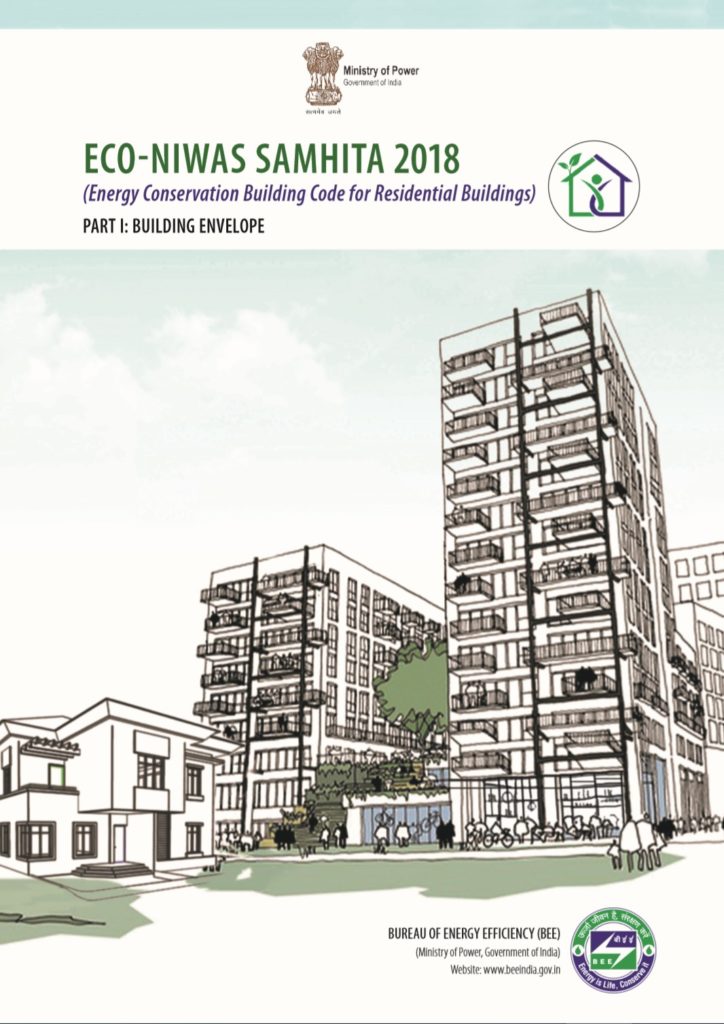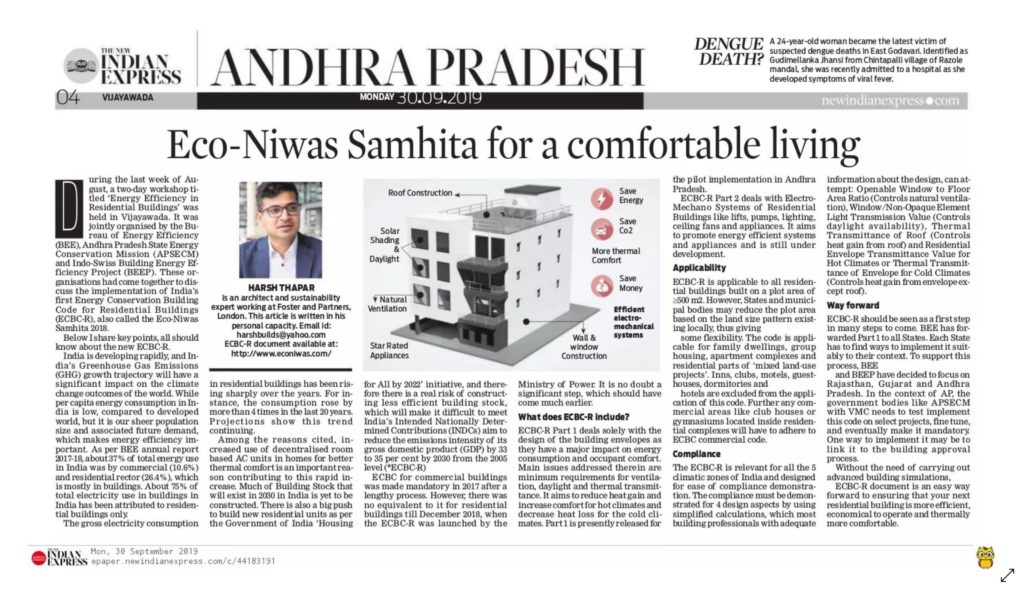During last week of August 2019, a two-day workshop took place in Vijayawada titled ‘Energy Efficiency in Residential Buildings’. Jointly organised by the Bureau of Energy Efficiency (BEE), A.P. State Energy Conservation Mission (AP-SECM) and Indo-Swiss Building Energy Efficiency Project (BEEP). These organisations had come together to discuss the Implementation of India’s first Energy Efficiency Code for Residential Buildings ( ECBC-R ), also called the Eco-Niwas Samhita. A detailed view of this new Code was provided to representatives of A.P. State government, Architects and Engineers along with some Academics & Students. Below I share key points, all should know about the new ECBC-R.

India is developing rapidly, and India’s Green House Gas Emissions (GHG) growth trajectory will have a significant impact on the Climate Change Outcomes of the world. While per capita energy consumption is India is low as compared to developed world but it’s our sheer population size and associated future demand which makes energy efficiency important. As per BEE annual report 2017-18, about 37% of total energy use in India was by Commercial (10.6%) and Residential Sector (26.4%) in 2017, which is mostly in the buildings. About 75% of total electricity use in buildings in India has been attributed to Residential buildings only.
The gross electricity consumption in residential buildings has been rising sharply over the years. For instance, the consumption figure rose by more than 4 times in last 20 years. Projections show this trend continuing. Amongst reasons cited, increased use of decentralized room based air-conditioning units in homes for better thermal comfort is an important reason contributing to this rapid increase.
Much of Building Stock that will exist in 2030 in India is yet to be constructed. There is also a big push to build new Residential Units as per the G.O.I. ‘Housing for All by 2022’ initiative, and therefore there is a real risk of constructing less efficient building stock which will make it difficult to meet India’s Intended Nationally Determined Contributions (INDCs) aim to reduce the emissions intensity of its gross domestic product (GDP) by 33 to 35 percent by 2030 from the 2005 level (* ECBC-R)
ECBC for Commercial buildings was made mandatory in 2017 after a lengthy process, however there was no equivalent to it for Residential Buildings till December 2018, when the ECBC-R was launched by Ministry of Power. It’s no-doubt a significant step which should have come much earlier.
What does ECBC-R include?
ECBC-R Part 1 deals solely with the design of the Building Envelopes as they have a major impact on energy consumption and occupant comfort. Main issues addressed therein are minimum requirements for Ventilation, Daylight and Thermal Transmittance. It aims to reduce heat gain and increase comfort for hot climates and decrease heat loss for the cold climates. Part 1 is presently released for the pilot implementation in Andhra Pradesh.
ECBC-R Part 2 deals with Electro-Mechano Systems of Residential Buildings like Lifts, Pumps, Lighting, Ceiling Fans and Appliances. It aims to promote energy efficient systems and appliances and is still under development.
Applicability:
ECBC-R is applicable to all residential buildings built on a plot area of ≥500 m2. However, states and municipal bodies may reduce the plot area based on the land size pattern existing locally, thus giving some flexibility. The code is applicable for family Dwellings, Group housings, Apartment complexes and residential parts of ‘mixed land-use projects’. Inns, Clubs, Motels, Guesthouses, Dormitories and Hotels are excluded from the application of this code. Further any commercial areas like club houses or Gymnasiums located inside residential complexes will have to still adhere to ECBC commercial code.
Compliance:
The ECBC-R is relevant for all the 5 climatic zones of India and designed for ease of compliance demonstration. The compliance must be demonstrated for 4 design aspects by using simplified calculations which most building professionals with adequate information about the design, can attempt:
1) Openable Window to Floor Area Ratio ( Controls Natural Ventilation )
2) Window/Non-Opaque Element Light Transmission Value ( Controls Daylight Availability)
3) Thermal Transmittance of Roof (Controls Heat Gain from Roof)
4) Residential Envelope Transmittance Value for Hot Climates OR Thermal Transmittance of Envelope for Cold Climates (Controls Heat Gain from Envelope except Roof)
The simplified methodology adopted can account for varying design, materials, climate and window fenestrations. Effect of over shadowing by surroundings is ignored for sake of simplification. A simple Java based calculator is available for download on BEE website which can used to carry out calculations. However, it is simple enough to be done on a computer spread sheet as well.
Way forward :
ECBC-R should be seen as a first step in many steps to come. BEE has forwarded Part-1 to all States. Each state has to find ways to implement it suitably to their context. To support this process, BEE and BEEP has decided to focus their efforts on Rajasthan, Gujarat and Andhra Pradesh. In context of Andhra Pradesh the Govt. bodies like AP-SECM with VMC needs to test implement this code on select projects, fine tune, and eventually make it mandatory. One way to implement it may be to link it to the building approval process.
Part 1 of ECBC-R is publicly available, and all building professionals should study it and immediately start informing their buildings with it. Without need of carrying out advanced building simulations, ECBC-R document is an easy way forward to ensuring that your next residential building is more efficient, economical to operate and thermally more comfortable for its occupants.

Author:
Harsh Thapar, is an architect and sustainability expert working at Foster and Partners, London. This article is written in his personal capacity.
ECBC-R document available at: http://www.econiwas.com/
